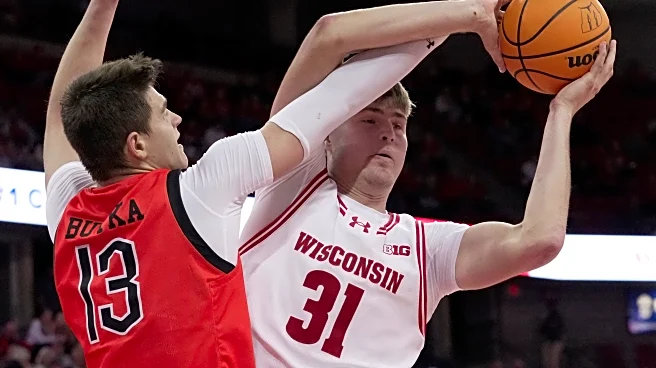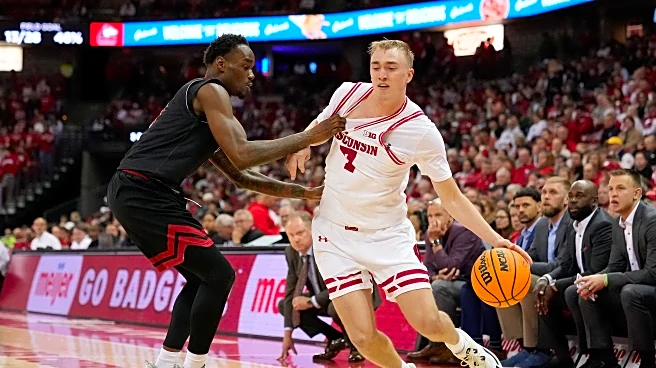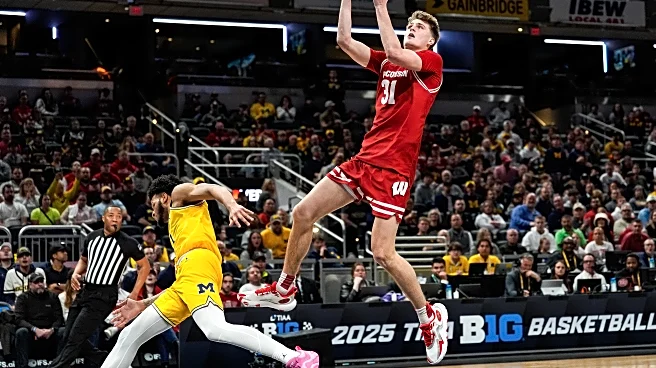The Wisconsin Badgers had another blowout victory on Tuesday, beating the Ball State Cardinals 86-55 as they narrowly missed out on the 90-point mark.
It was a game of runs for the Badgers, as they started
the game on a 27-6 run before later having a 21-5 run to really pull away in the second half.
Wisconsin’s defense was stellar on the night, while five different players reached double figures offensively.
Here are three quick takeaways from Wisconsin’s 86-55 win over Ball State on Tuesday.
Fast start
Maybe the slow starts were a one-off this season. Because the Badgers started the Northern Illinois game on a 20-5 run before taking a 39-18 lead in the first half, dominating their way to a win.
Against Ball State on Tuesday, Wisconsin started on a 27-6 run through the first 8:15. When the Badgers go on runs, head coach Greg Gard preaches defense. And that was definitely the case to start the game.
Wisconsin was locked in, both on and off the ball. Ball State tried to attack one-on-one too much, and Wisconsin just was more sound and physical. When they tried to get to the rim, the Badgers were able to block or alter a few shots, leading to inefficiency at the rim. Wisconsin also got the Cardinals late into the shot clock often and forced some bad threes.
The good defense led to good offense, as the Badgers were efficient to start the game, hitting their threes, while also taking advantage of the size mismatch down low. When Wisconsin is clicking like they were over that stretch, they look the part of an elite team.
Nick Boyd hit a pair of threes in the early going, while Andrew Rohde also put in five points. But, it was an overall team effort that the Badgers had, leading to the strong start that controlled the remainder of the game.
3-point shooting
The Badgers are going to shoot threes. They’re a team capable of it, with most of their players being quality shooters over the course of their careers so far. The analytics also play into it, as Wisconsin tries to generate most of its shots at the rim, the free-throw line, or from beyond the arc.
Well, that was seen at the beginning of the game as four of the team’s first six shots came from three, with the Badgers connecting on only one of those.
Wisconsin started the game 1/5 from three before getting hot, proceeding to make four of their next six, which sparked the team’s 27-6 start. But, they went ice cold from there on as Ball State went into a 2-3 zone to take away some of the paint touches.
The Badgers proceeded to finish the first half 1/12 from deep to go 6/23 from three in the half. Over 60 percent of the team’s first-half looks were threes. Yes, Ball State was actively looking to keep the Badgers on the perimeter, but it also felt like Wisconsin settled from deep at times early in the game.
If they’re falling, there’s no problem in continuing to rely on the deep ball. And we’ve seen stretches where Wisconsin has gotten really hot from three early in the season, just as they did for a stretch in the first half.
But, when they aren’t falling at a high rate, the Badgers need to be more aggressive, which also falls on Gard to generate some open looks against the zone. Wisconsin’s ball movement continued to excel, but the shots just weren’t falling in the first half, and the offense became stagnant, scoring only nine points over the final 10:47 of the period.
In the second half, Wisconsin adjusted well, starting the half hot. They opened the half on a 24-10 run, going 9/11 from the field and 3/4 from three. The Badgers looked to attack early, with their first four shots all being scored at the rim. That continued on over the first nine minutes, as Wisconsin attacked to open up the three-point shots, finding high-percentage looks beyond the arc.
Wisconsin finished the second half 8/15 from three, taking them to a respectable 14/38 for the game. But, after some shaky stretches in the first half, we saw the necessary adjustments from the Badgers for a much more efficient and consistent second half.
Defense
We have to applaud the Badgers’ defense, which is already looking improved from the preseason. Yes, you have to factor in the opponent, but Wisconsin did a great job both on and off the ball on Tuesday.
In the first half, a big part of the team’s 27-6 start was due to the defense. Andrew Rohde continued to be stellar on-ball, even recording an off-ball steal with a great read to prevent a layup late in the half. But, he wasn’t the only one.
I thought Wisconsin’s bigs were very solid with going straight up and rotating on the block. They were forces at the rim, where Ball State struggled to get a rhythm. I also thought they rebounded fairly well on both sides of the court, with Nolan Winter and Aleksas Bieliauskas combining for 13 rebounds in 20 minutes of action.
Wisconsin also forced the team late into shot clocks, as mentioned above, and forced a lot of ugly threes, where the Cardinals were only 3/14 in the first half.
The Badgers forced eight turnovers in the first 20 minutes, while recording four blocks and limiting Ball State to just 32.1 percent from the field.
In the second half, Wisconsin got out to another strong start, as Ball State only scored 10 points over the first 10 minutes of the period. During that stretch, the Cardinals were 3/13 from the field and 1/4 from three, scoring just 0.625 points per possession. More importantly, the Badgers didn’t allow many second-chance opportunities, rebounding well with the size advantage.
The bigs continued to play really well at the rim, with Aleksas Bieliauskas, Nolan Winter, and Austin Rapp all blocking shots. The Badgers also forced turnovers, as the defense turned into offense once again.
Wisconsin’s defense has led to its biggest runs this season, and that was the case again on Tuesday when the Badgers went on a 29-7 run to extend their lead to a game high 35 at 73-38.
Overall, the Badgers held Ball State to 55 points, limiting them to 34 percent from the field and 7/23 from three. It was Wisconsin’s best defensive game of the season from the small sample size so far.












